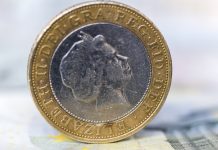Even though the UK avoided a no deal Brexit this week, the pound still moved lower on Thursday. The pound US dollar exchange rate tumbled 0.2% to close at US$1.3066.
| What do these figures mean? |
|---|
| When measuring the value of a pair of currencies, one set equals 1 unit and the other shows the current equivalent. As the market moves, the amount will vary from minute to minute.For example, it could be written:1 GBP = 1.28934 USDHere, £1 is equivalent to approximately $1.29. This specifically measures the pound’s worth against the dollar. If the US dollar amount increases in this pairing, it’s positive for the pound. Or, if you were looking at it the other way around:1 USD = 0.77786 GBPIn this example, $1 is equivalent to approximately £0.78. This measures the US dollar’s worth versus the British pound. If the sterling number gets larger, it’s good news for the dollar. |
The pound continued to struggle in the previous session. Even though the UK has been granted an extension to Article 50 until 31st October, pound investors are still wary. The Brexit deadlock has not been solved by the extension. Investors are watching carefully to see how the next chapter develops.
UK Prime Minister Theresa May continues in talks with Jeremy Corbyn, the leader of the opposition. There have been conflicting reports as to how the talks are progressing. Suggestions that Theresa May could be softening her stance on the idea of the UK remaining in the customs union, could make a deal with Jeremy Corbyn more plausible. Theresa May still believes that she can get a deal through Parliament next month. The fact that the pound fell, suggests that pound traders are not so convinced.
| Why is a “soft” Brexit better for sterling than a “hard” Brexit? |
|---|
| A soft Brexit implies anything less than UK’s complete withdrawal from the EU. For example, it could mean the UK retains some form of membership to the European Union single market in exchange for some free movement of people, i.e. immigration. This is considered more positive than a “hard” Brexit, which is a full severance from the EU. The reason “soft” is considered more pound-friendly is because the economic impact would be lower. If there is less negative impact on the economy, foreign investors will continue to invest in the UK. As investment requires local currency, this increased demand for the pound then boosts its value. |
There is no high impacting UK economic data due for release today. Market participants will continue watching Brexit headlines closely. There are a growing number of calls from Conservative ministers for Theresa May to quit. Theresa May stepping down would create further political instability and could raise the prospect of a no deal Brexit should a hard line Brexiteer take control. These scenarios are pound negative.
Dollar Higher As US Unemployment Claims Hit 49 Year Low
Strong US data helped lift the dollar on Thursday. Data showed that the US labour market was still strong. US jobless claims dropped to a 49 year low amid signs that the labour market continues to tighten. The number of people filing for unemployment benefits unexpectedly dropped to 196,000 in the week ending April 6th. This is the fourth straight drop in claims, indicating that the US labour market is firm. A strong labour market creates inflationary pressures which boosts the dollar.
| How does strong jobs data boost the currency? |
|---|
| It works like this, when there is low unemployment and high job creation, the demand for workers increases. As demand for workers goes up, wages for those workers also go up. Which means the workers are now taking home more money to spend on cars, houses or in the shops. As a result, demand for goods and services also increase, pushing the prices of the goods and services higher. That’s also known as inflation. When inflation moves higher, central banks are more likely to raise interest rates, which then pushes the worth of the currency higher. |
Thursday’s figures come after the Fed indicated that they could be looking at cutting interest rates later this year.
Today investors will continue to watch the US economic calendar, with US consumer sentiment under the spotlight. Analysts predict that consumer sentiment ticked lower in April.
This publication is provided for general information purposes only and is not intended to cover every aspect of the topics with which it deals. It is not intended to amount to advice on which you should rely. You must obtain professional or specialist advice before taking, or refraining from, any action on the basis of the content in this publication. The information in this publication does not constitute legal, tax or other professional advice from TransferWise Inc., Currency Live or its affiliates. Prior results do not guarantee a similar outcome. We make no representations, warranties or guarantees, whether express or implied, that the content in the publication is accurate, complete or up to date. Consult our risk warning page for more details.
This article was initially published on TransferWise.com from the same author. The content at Currency Live is the sole opinion of the authors and in no way reflects the views of TransferWise Inc.





